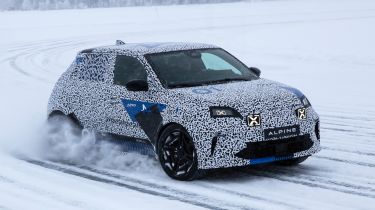New Alpine A290 prototype review: electric hot hatch shows plenty of promise
We get behind the wheel of the Alpine A290 electric hot hatch as it concludes winter testing in camouflage
This is our first chance to drive the new Alpine A290 in camouflaged prototype form. The new, all-electric hot hatch is in the final stages of its development, and we’ve joined Alpine’s engineers to test the car at its development centre in the frozen north of Sweden.
The Alpine A290 is closely related to the new Renault R5 electric hatchback, which will be revealed at the 2024 Geneva Motor Show. This is far from an R5 with a different badge, however; Alpine’s version is being developed separately, with unique front suspension, wider dimensions, more power, different brakes and unique driving modes, among other distinctions.
The final, production-spec Alpine A290 will be revealed to the world in June, and the first deliveries to customers are expected around October 2024.
Winter testing will conclude in March, and final calibrations will be signed off in April. Today we’re driving two different prototypes, on the frozen lake that Alpine uses to develop the car’s powertrain, braking, low-grip handling and stability safety systems.
Although the prototypes are thoroughly camouflaged, it’s possible to make out the car’s shape and its features. The A290 has a relatively short wheelbase, at 2.5 metres, with 19-inch wheels giving it a chunky, wheel-at-each-corner stance. Those wheels will be available with a distinctive square-spoke design, similar to that of the 2023 A290–ß concept which first introduced the car. Like that car, distinctive X-shaped running light pods will make the A290 recognisable as an Alpine from a distance.
Whilst the dashboard is clad with black fabric to disguise its final design, the steering wheel is fully exposed, with two key additions for the Alpine, both inspired by the steering wheel in its F1 cars: an ‘OV’ (for ‘Overtake’) button, which gives a dramatic extra shot of power from the motor, and a switch to adjust the amount of regenerative braking, similar to the item that Esteban Ocon and Pierre Gasly toggle for their KERS system in Formula One.
Like the Renault R5, the A290 production car is a single-motor, front-wheel-drive car, albeit with a different, more powerful motor. It uses torque vectoring by braking to help put its power down to the ice, as well as sophisticated traction control. This is very much evident in our drive at Alpine’s facility, with multiple handling track layouts and skid surfaces.
With the drive mode set to Normal, it’s remarkable how stable and controlled the A290 is, no matter how deliberately clumsy you are with the pedals or steering. In Sport, it allows a certain amount of sliding, but remains very safe and controlled. In true sports-car style, it is possible to fully disable the stability control system, and let the A290 slide to the point where you’re looking at out of the side windows rather than the windscreen.
Alpine’s engineers have worked hard to make the A290 feel easy and intuitive to drive, and its steering, braking and accelerator maps are all designed to feel very similar to those of the A110 sports car. Vice-president of engineering Robert Bonetto says the team have deliberately avoided the shock and awe of a very sensitive accelerator pedal for dramatic acceleration, a trait of some EVs from other manufacturers (though he doesn’t reference cars by name).
Instead the throttle response, while certainly smart, places more emphasis on being smooth and progressive. If drivers do want dramatic acceleration, that’s where the OV button comes in. Pressing it gives an instant bump in power (Alpine won’t say how much; it’s remaining tight lipped on performance figures for the time being), pushing you back in the seat. Release the button and all returns to normal.
Likewise, Alpine hasn’t gone overboard with the brake-energy regen, using the Recharge switch on the wheel. In Eco mode there is barely any braking from the motor, which Alpine’s engineers say is actually the most efficient way of conserving energy. Toggling the switch allows you to change through three levels of energy recovery, from a mild deceleration similar to the normal engine braking you would experience in a petrol-powered Alpine A110, up to a more noticeable retardation when you lift from the accelerator. Again, it’s not a dramatic or uncomfortable sensation.
This car needs to be a bigger seller than the niche A110 sports car, and so it has to have a relatively affordable price; however, it is expected to be considerably more expensive than the Renault R5. The final numbers will be revealed closer to the A290’s official reveal in June.
Alpine has committed to producing seven new electric cars by 2030, under the ambitious plans of Renault CEO Luca de Meo. This is the only new Alpine model that will share a platform with Renault; future Alpines, including a new electric SUV and an electric sports-car successor to the Alpine A110, will be built around a brand-new, Alpine-specific structure.
The A290 represents a significant first step in the all-electric expansion of the Alpine road-car brand, and based on this first experience, it will be a well-rounded, characterful - and fun - purely electric hot hatch.


